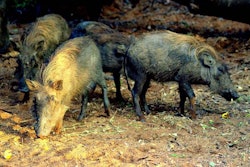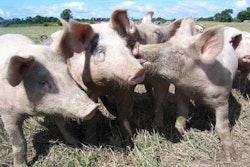
Rabobank says China is expected to import 3.5 million metric tons of pork this year
China’s pork imports are expected to set a record in 2020, as the country continues to deal with the effects of two major viruses – African swine fever (ASF) and the novel coronavirus (COVID-19).
Rabobank, in its June ASF global update, said it maintains its view that China’s pork imports will set a record in 2020 at 3.5 million metric tons. China’s pork meat imports were up 180% and variety meat imports were up 29% year over year in the first four months of 2020. The U.S. has become the largest supplier of pork to China, with imports from the U.S. increasing sixfold over 2019 levels.
COVID-19 is expected to cause tightening supply of pork in all major producing countries, as well as a reduction in pork consumption.
“The reduction in consumption will not, in our view, make up for reduced production, resulting in relatively tight pork markets,” the report said.
COVID-19-related closures caused weak animal protein consumption in the first half of 2020; retail prices of all proteins have fallen, with poultry prices seeing the largest drop. Consumption growth of broiler meat overall in 2020 in China is expected to slow significantly as a result of COVID-19, economic downturn and slow foodservice demand. Consumption is expected to improve in the second half.
ASF continues to spread in China, but at a slower pace and without widespread outbreaks. Rabobank expects China’s pig herd to rebound “strongly” in the second half of 2020, and it has adjusted its forecast of the herd to a higher level by the end of the year.
Positive margins and government support are driving restocking. Common practice in China for herd restocking is gilt retention.
“It is estimated that half of the sow herd is three-line-crossbred female hogs,” the report said, adding, “due to genetic differences, these sows have inferior productivity, further slowing feed demand.”
China’s official data shows pork meat output fell by 29% year over year in the first quarter. It is expected to have a smaller decline in the second quarter. For the year, Rabobank said it maintains its forecast that pork meat output will fall 15% to 20% year over year, and pig slaughter numbers will fall more. The average weight estimated to increase by more than 10% due to extended fattening periods, which is good for hog feed usage.
Overall hog feed usage is expected to decline again in 2020. Total feed usage is expected to rebound by 2% year over year, with soybean meal use rising 3% to 4%.
“Amid positive margins, hog farms are adopting high-protein feed formulas, to enhance pigs’ health,” the report said. “In addition, poultry farms are using more soymeal to replace other protein meals.”
In recent months, China has purchased more U.S. corn and sorghum, but trade tensions between the two countries could affect feed corn usage.
ASF outbreaks continue in Vietnam and the Philippines
Outbreaks of ASF continue in 19 of Vietnam’s provinces, and 30,000 pigs were lost in the first five months of 2020. Rabobank expects the country’s sow herd to reach 2.9 million by the end of 2020, and the total herd to reach 22 million. Vietnam’s pork production in the first quarter reached 592,000 metric tons, which is down 19.3% from the same period in 2019. Pork production is expected to decline 8% to 11% year over year.
ASF outbreaks in the Philippines continue in backyard farms in Luzon at a “relatively constant” pace. Rabobank says it is maintaining its forecast for a 12% decline in the country’s sow herd, but said if the disease spreads beyond Luzon, the worst-case scenario would be that the sow herd drops by up to 29% and the total herd by 28%. Philippine pork production is expected to decline 9% year over year.
Hog feed consumption in Vietnam and the Philippines is forecast to decrease by 8.2% and 9.3%, respectively. Total consumption of broiler feed, layer feed and aquafeed in Vietnam is expected to be flat, while it is forecast to fall by 1.2% in the Philippines. Total animal feed consumption in Vietnam and the Philippines will decrease 4.4% and 6%, respectively, in 2020.
Vietnam’s corn demand for feed is expected to fall 4.6%, while demand for soybean meal for feed will fall 4.4%. In the Philippines, corn demand for feed is expected to fall 5.9%, while demand for soybean meal for feed will fall 5.8%. Imports of these ingredients to both countries is expected to be flat.
View our continuing coverage of the African swine fever outbreak.
View our continuing coverage of the novel coronavirus (COVID-19) pandemic.
















